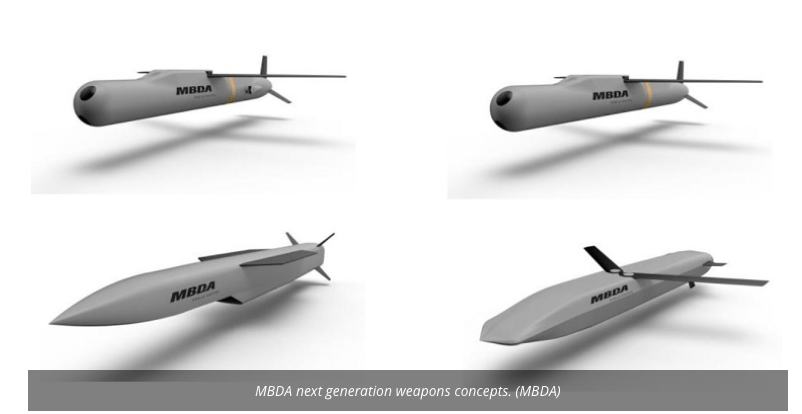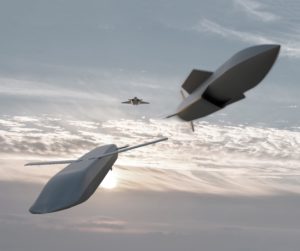By Pierre Tran
Paris Air Show 2019
MBDA, a missile builder, displayed at the Paris air show life-size models of concepts for cruise missiles and tactical smart weapons as options for the Future Combat Air System, a European plan for a new fighter jet and other weapons.
A Spear missile was also on show at the MBDA exhibition chalet, signaling the European company’s targeting sales to operators of the F-35 fighter.
The UK’s development contract for the air-to-ground weapon opened up a global market on the joint strike fighter and prospects on the British Tempest new air combat systems project.
These displays give a glimpse of weapons which might be used to outsmart the anti-access, area denial systems deployed by enemy forces.
For allies planning a deep strike mission, there are mock ups of concepts for subsonic and supersonic cruise missiles, potential replacements to the Storm Shadow/Scalp British and French weapons.
The former would weigh around one ton, fly more than 1,000 km to hit hard targets such as concrete bunkers and command centers.
The latter would have speed of Mach 2 and more, and offer agility in flight.

For tactical strike, there are models of Smart Glider and a powered version, Smart Cruiser.
The former would not have an engine and would be guided by a targeting system of infrared, laser and GPS. The latter would have a motor and range of some 200 km.
Both these would be part of the FCAS combat cloud, connected to fighter pilots and ground control, loaded with artificial intelligence for a target designator, with their use set by rules of engagement.
These weapons could be used as a “swarm” to saturate air defense systems such as the S300 or S400 missile.
The destructive power of warheads could be scaled up or down according to operational need, with the weapons small enough to fit six units on a contact point. That would allow up to 18 weapons on a Rafale, or four units in each of the internal weapons bay on the FCAS fighter.
MBDA invested company funds on studies for the Smart Glider, and a couple of countries are interested in ordering the weapon, an executive said.
There are also two types of small drones weighing 150 kg and 250 kg, dubbed remote carriers. These are derived from Smart Glider, and designed to carry sensors and “effectors” such as electronic warfare payloads to confuse or hit an integrated air defense system.
Such a powered, low-cost drone might emulate a Rafale, tricking the defense system and act as decoy. Speeds of Mach 0.75 to 0.9 on a small turbojet are envisaged.
Another type of concept weapon consists of a small anti-missile missile, a last chance “ultimate defense” a pilot would fire against an approaching missile.
This could be a “hard kill” weapon working on kinetic strike, and would be a complement to self-defense tools such as chaff, flares and electronic jamming.
There could be at least four of these weapons, each weighing less than 10 kg and less than one meter long. MBDA is pitching the concept to Airbus and Dassault Aviation for the FCAS fighter.
The Meteor missile is also on show, and the reach of this long-range weapon could be extended. There are studies for an upgrade with a multimode seeker for future models.
MBDA signed up as a partner on the FCAS joint concept study led by Airbus and Dassault.
2019-06-17-MBDA-unveils-its-vision-of-Future-Air-SystemsAlso, see the following:
The Combat Cloud at the Heart of the Future Combat Air System


